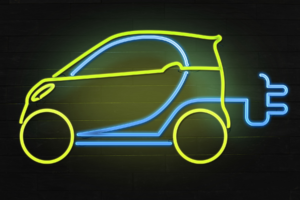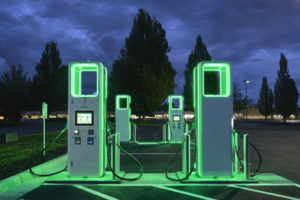FIRST ON THE ROAD
Although electric vehicles (EVs) are currently challenging the dominance of internal combustion engine (ICE) cars, they have actually been around for more than a century. In fact, at the turn of the 20th century, there were more electric cars on the road than traditional petrol-powered ICE vehicles. However, the advent of Ford’s moving assembly line made petrol cars more accessible to the wider population, and their prevalence began to overtake electric cars. Ford’s decision to build a transportation system based on petrol, which was more widely available than electricity, cemented petrol cars as the primary mode of transportation for over a hundred years. Despite intermittent experimentation with electric mobility in the intervening decades, it wasn’t until the turn of the next century that electric cars re-emerged as a viable option. Now, 20 years later, EVs are more popular than ever. But looking back in time, we provide an overview of the history of EVs and those tinkering with electric mobility in the intermittent decades before it rose to a current prominence.
A WIN FOR BRITAIN, USA AND HUNGARY
Investors in Hungary, the Netherlands, the UK, and the US were already exploring ways to combine technological developments and create a powered motor vehicle as early as the 1830s. Although there is debate, some claim that the first small-scale electric cars were developed between 1828-1832. In 1835, British inventor Robert Anderson displayed the first electric vehicle at an industry conference. His vehicle utilized a disposable battery powered by crude oil to turn the wheels. However, Anderson was not the only one working on electric mobility. Around the same time, Hungarian scientist Ányos Jedlik and Dutch professor Sibrandus Stratingh also invented model EVs. Meanwhile, Thomas Davenport, an American blacksmith-turned-inventor, is also credited with inventing integral components of the electric motor which led to the development of the first electric car.
IMPRACTICAL MOBILITY
Despite these early developments, the prototypes of electrified carts could only travel at a maximum speed of 7 mph with cumbersome steering and limited range. It wasn’t until the 1860s that French physicist Gaston Plante invented the first rechargeable lead-acid battery, which was a significant breakthrough for electric mobility. However, it took until the late 1880s for electric mobility pioneer William Morrison to combine these batteries and electric motors to create the first practical EV.
AN EV SENSATION
In 1859, the introduction of rechargeable batteries increased the feasibility of the electric-car concept. In England, inventor Thomas Parker aided in the implementation of electric-powered trams and constructed prototype electric vehicles by 1884. Meanwhile, William Morrison, a chemist from Scotland residing in Des Moines, Iowa, had constructed an electric carriage as early as 1887 and applied for a patent on it in 1890. The Des Moines Register reported that the carriage made an appearance in a city parade in 1888. Equipped with front-wheel drive, 4 horsepower, and capable of reaching a top speed of 20 mph, it necessitated recharging every 50 miles with its 24 battery cells. At the 1893 Chicago World’s Fair, Morrison’s self-propelled carriage was a sensation, attracting the attention of other inventors despite Morrison’s greater interest in batteries rather than mobility. It could carry up to 12 people.
STEAM | PETROL | ELECTRIC
As the 20th century approached, the popularity of motorised vehicles grew rapidly, replacing traditional horse-drawn carriages. The battle for the future of mobility began with three options: steam, petrol, or electric. In the US, the market was evenly split with steam vehicles holding a slim majority, followed by electric and petrol-powered vehicles. However, steam vehicles ultimately faced a major setback due to their long startup time and the need for constant refilling with water, making them impractical for personal vehicles.
FIRST ON THE ROAD – THE FIRST ICE CARS
Back in 1886, Gottlieb Daimler and Carl Benz developed the world’s first automobiles in Germany powered by petrol. However, these vehicles required gear changes, and heavy hand cranks to start and were noisier with unpleasant emissions from their exhaust. In contrast, electric cars proved to be a competitive option, being easier to drive, quieter, and emitting no pollutants. This made electric cars a popular choice among urban residents where electricity was readily available, and as more people gained access to electricity, their popularity grew. However, this momentum was halted by Ford’s cost-efficient assembly line and the wider availability of petrol.
FIRST ON THE ROAD – THE ELECTROBAT
The Electrobat, a name worthy of admiration, marked the first commercially successful effort in the EV industry. Philadelphia residents Pedro Salom and Henry G. Morris secured a patent in 1894 after adapting technology from battery-electric streetcars and boats. Initially heavy and slow, their Electrobat evolved over time, featuring pneumatic tires and lighter materials. By 1896, their rear-steer carriages utilized two 1.1-kW motors to travel 25 miles at a top speed of 20 mph, winning a series of five-mile sprint races against gasoline-powered Duryea automobiles.
RECHARGING IN AN ICE ARENA
Incorporating that same year, Morris and Salom transitioned to the “cash-in” phase of their successful startup. They designed and built several electric Hansom cabs to compete with horse-drawn vehicles in New York, which they then sold to Isaac L. Rice. Rice incorporated the Electric Vehicle Company (EVC) in New Jersey and attracted significant investors and partners. By the early 1900s, EVC operated more than 600 electric cabs in New York and smaller fleets in Boston, Baltimore, and other eastern cities. To combat the battery recharge downtime, EVC transformed an ice arena into a battery-swapping station, allowing a cab to swap spent batteries with fully charged ones and continue its journey.
EXPANDING TOO QUICKLY
However, despite its innovative approach, EVC expanded too quickly and encountered unexpected conflicts among its investors and partners, leading to the collapse of the entire taxi venture by 1907. EVC’s battery supplier, which was also an investor and partner, later became known as Exide. Pope, EVC’s manufacturing partner and petrol-car pioneer, adopted the technology and applied the name “Columbia” from its thriving bicycle business to a line of cars for public sale. Columbia reached the 1000-units-built milestone well before visionary mass manufacturers in Detroit, Ransom Olds, and Henry Ford accelerated their production.
DARKEST BEFORE THE DAWN
Electric vehicles experienced their darkest hour with the advent of mass-produced internal combustion engine (ICE) vehicles. The introduction of Ford’s Model T made petrol-powered cars widely accessible and affordable. The discovery of oil in Texas further made petrol cheap and readily available for many, while electric charging infrastructure remained limited to urban areas. Over the following 30 years, electric vehicles made little progress and by the mid-1930s were virtually non-existent. The availability of cheap and abundant petrol, coupled with continuous advancements in the ICE engine, stifled demand for alternative fuelled vehicles and solidified petrol-powered vehicles’ dominance. Consequently, the electric car remained in a dormant state for the better part of a century.
OIL PRICE IMPACT
In the 1970s, as oil prices skyrocketed and petrol shortages became a common occurrence, there was a growing interest in reducing society’s reliance on oil. Vehicle manufacturers responded to this social shift by exploring alternatives to petrol-powered vehicles, including electric cars. General Motors, for example, developed a prototype for an urban electric car, while NASA’s electric Lunar rover became the first manned vehicle on the moon, raising the profile of electric vehicles. However, electric cars still had several drawbacks compared to petrol-powered vehicles, such as limited range and slow top speeds, which made them unappealing to consumers.
REVOLUTION
Despite the lack of public interest, scientists and engineers persisted in their efforts to improve EVs. Over the next two decades, vehicle manufacturers modified popular models to create electric variations, hoping to improve the batteries and achieve a range and speed closer to that of petrol-powered vehicles. The introduction of the Toyota Prius was a significant turning point. Released in Japan in 1997 as the world’s first mass-produced hybrid EV, it became an instant success when it was released worldwide in 2000. However, the real breakthrough came in 2003 when two entrepreneurs, Martin Eberhand and Marc Tarpenning, saw an opportunity. Impressed by the increasing capacity of lithium-ion batteries, they founded Tesla Motors in 2003. By 2006, the startup from Silicon Valley had announced its plan to manufacture a high-end electric sports car with a range of over 198 miles on a single charge. This paved the way for the EV success story that we see today and the rEVolution.











